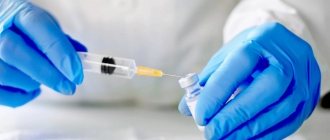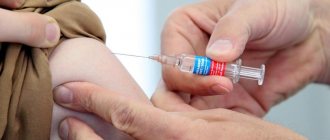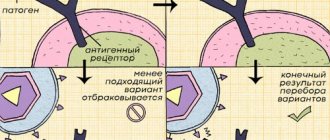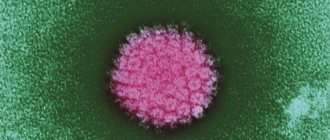Rabies immunoglobulin from human blood serum
Repeated administration of the drug should not be carried out after the start of an immunization program with rabies vaccine, because may reduce maximum immunity.
As soon as possible after the bite and regardless of the time elapsed after contact, surgical and antiseptic treatment of the wound should be carried out (including copious washing with soap and water and disinfection using quaternary ammonium salts). Immediate suturing of the wound is contraindicated; if necessary, a simple connection of its edges is permissible.
In case of hypersensitivity to blood products (history), antihistamines should be used (careful monitoring of the patient is necessary).
Before using attenuated live viral vaccines, it is recommended to maintain an interval of at least 6 weeks (preferably 3 months) after the administration of Ig. If during the previous 2 weeks the patient was vaccinated with a live attenuated viral vaccine (for the prevention of measles, rubella, mumps, chickenpox), to assess the feasibility of administering an additional dose, it is recommended to monitor the post-vaccination protective level of antibodies (3 months after the administration of rabies Ig).
IV administration of Ig is contraindicated (due to the risk of shock), so when injecting, you must make sure that the needle does not penetrate a blood vessel.
After administration of the drug, the patient should be under medical supervision for at least 20 minutes.
After Ig administration, a temporary increase in antibody levels may cause false-positive results in serological tests. To avoid possible interactions between several different drugs, you should tell your doctor about any other therapy you are taking.
The risk of post-vaccination infection with pathogens of infectious diseases is reduced with careful control of the selection of donor blood through a medical questionnaire survey of donors, as well as the study of each donated volume of blood, especially in relation to the HIV-1, HIV-2 viruses, hepatitis B virus, hepatitis C virus, and during the isolation/purification procedure, which includes virus elimination (precipitation in ethanol) and inactivation (pasteurization at 60 degrees C for 10 hours).
It should be borne in mind that Igs are secreted in mother's milk and can contribute to the transfer of passive immunity to the child.
Antirabies immunoglobulin from human blood serum (Immunoglobulin antirabies)
Immediately or as soon as possible after a bite or injury, mandatory local treatment of the wound is carried out. Wounds are washed abundantly with soap and water or any detergent and treated with 40-70% alcohol or 5% alcohol solution of iodine. In cases where there are indications, surgical treatment of the wound is performed.
After local treatment of the wound, specific treatment begins immediately. Before injection, check the integrity of the bottle and the presence of markings on it. The drug is not suitable for use in bottles with damaged integrity, labeling, as well as if its physical properties (color, transparency, etc.) have changed, if the expiration date has expired, or if the storage regime has been violated.
The opening of the bottles and the procedure for administering the drug are carried out in strict compliance with the rules of asepsis and antiseptics.
A skin test is not required before administration.
The drug is administered as early as possible after treatment in a single dose of 20 IU/kg body weight of an adult or child.
An example of calculating the dose of immunoglobulin:
The victim's body weight is 60 kg.
For example, the actual activity of the immunoglobulin of this series, indicated on the bottle label or on the packaging, is 200 IU/ml.
In order to determine the dose of immunoglobulin in ml required for administration, you need to multiply the weight of the victim (60 kg) by 20 IU and divide the resulting number by the activity of the drug (200 IU/ml), i.e.
60×20/200=6 ml
As much of the calculated dose as possible should be infiltrated around and deep into the wound, if anatomically possible.
The rest should be injected intramuscularly:
- adults:
in the upper outer quadrant of the gluteal muscle;
- for children:
into the anterolateral surface of the thigh.
For children (especially those with multiple wounds), a dose of rabies immunoglobulin from human blood serum can be diluted 2-3 times with a sterile 0.9% sodium chloride solution to a volume that ensures complete infiltration of the affected areas of the body.
Anti-rabies immunoglobulin from human blood serum is administered no later than 7 days after contact with a patient with rabies or an animal suspected of rabies.
Anti-rabies immunoglobulin from human blood serum is used in combination with an anti-rabies vaccine for category 3 damage, a detailed description of the nature of contact with the animal, data about it, as well as the treatment regimen are described below in the table:
Scheme of therapeutic and prophylactic vaccinations with rabies vaccine and rabies immunoglobulin from human blood serum (ARIG)
| Category damage | Nature of contact | Animal details | Treatment |
| 1 | No damage to the skin, no drooling of the skin, no drooling of the mucous membranes | Rabies patient | Not assigned |
| 2 | Salivation of intact skin, abrasions, scratches, superficial bites of the torso, upper and lower extremities (except for areas of the head, face, neck, hand, fingers and toes) caused by domestic and farm animals | If within 10 days of observation of the animal, it remains healthy, then treatment is stopped (i.e. after the 3rd injection). If the absence of rabies in an animal is laboratory proven, then treatment is stopped from the moment the absence of rabies is established. In all other cases, when 10-day observation of the animal is impossible (killed, died, ran away, disappeared, etc.), treatment is continued according to the specified scheme | Start treatment immediately: 1.0 ml vaccine on days 0, 3, 7, 14, 30 and 90 |
| 3 | Any drooling of the mucous membranes, any bites of the head, face, neck, hand, fingers and toes, genitals; single or multiple deep lacerations caused by domestic or farm animals. Any salivation or damage caused by wild carnivores, bats and rodents | If within 10 days of observation of the animal, it remains healthy, then treatment is stopped (i.e. after the 3rd injection). If the absence of rabies in an animal is laboratory proven, then treatment is stopped from the moment the absence of rabies is established. In all other cases, when 10-day observation of the animal is not possible, treatment is continued according to the specified regimen. | Start combination treatment immediately Rabies immunoglobulin from human blood serum V 0 day and rabies vaccine: 1.0 ml on days 0, 3, 7, 14, 30 and 90. |
Combined treatment with Rabies Immunoglobulin from human blood serum and rabies vaccine should be carried out under strict compliance with the following conditions:
- First, anti-rabies immunoglobulin is administered from human blood serum, and no more than 30 minutes after it, the anti-rabies vaccine is administered.
The sequence of administration of anti-rabies drugs must be strictly observed!
Administration of ARIG after administration of rabies vaccine is not allowed.
-Rabies immunoglobulin and rabies vaccine should be administered to different parts of the body using different syringes.
The dosage of immunoglobulin should not be exceeded under any circumstances, since the administration of an increased dose of immunoglobulin may partially suppress the production of antibodies.
If emergency tetanus prophylaxis is necessary, the latter is carried out after the administration of rabies immunoglobulin and the first vaccination of rabies vaccine.
Rabies immunoglobulin from human blood serum (China)
Instructions for use:
ANTI-RABIC IMMUNOGLOBULIN FROM HUMAN BLOOD SERUM
Registration number:
LSR-010494/08 from 241208.
Group name
. Anti-rabies immunoglobulin.
Anti-rabies immunoglobulin from human blood serum, solution for injection, is a concentrated solution of the purified gamma-globulin fraction of human blood serum, isolated by cold extraction with ethanol and subjected to a process of ultrafiltration, purification and viral inactivation at a pH value of 4.0 and a temperature of 23-25 ° From within 21 days.
Composition (per 1 ml).
Specific antibodies to the rabies virus, not less than 150 IU; stabilizer glycine (glycocol) from 20 to 25 mg; sodium chloride 7 mg; water for injections.
The drug does not contain antibiotics.
HBsAg, antibodies to HIV-1, HIV-2 and hepatitis C virus are absent.
Description.
Transparent or slightly opalescent liquid, colorless or light yellow.
Immunological properties.
The drug contains specific antibodies that can neutralize the rabies virus.
Pharmacokinetics.
The maximum concentration of antibodies is achieved 2-3 days after intramuscular injection of rabies immunoglobulin. The half-life of antibodies is 3 to 4 weeks.
Purpose.
Used in combination with an anti-rabies vaccine to prevent people from developing hydrophobia due to severe multiple bites by rabid or suspected rabid animals.
In case of a repeated multiple bite by an animal with rabies or an animal suspected of rabies, rabies immunoglobulin is not prescribed if, during the first bite, the victim received a full combined course of treatment with rabies immunoglobulin and rabies vaccine.
Directions for use and dosage.
Immediately or as soon as possible after a bite or injury, mandatory local treatment of the wound is carried out. Wounds are washed abundantly with soap and water or any detergent and treated with 40-70% alcohol or tincture of iodine. In cases where there are indications, surgical treatment of the wound is performed.
After local treatment of the wound, specific treatment begins immediately. Before injection, check the integrity of the bottle and the presence of markings on it. The drug is unsuitable for use in bottles with damaged integrity, labeling, as well as if its physical properties (color, transparency, etc.) have changed, if the expiration date has expired, or if storage conditions have been violated.
The opening of the bottles and the procedure for administering the drug are carried out in strict compliance with the rules of asepsis and antiseptics.
A skin test is not required before administration.
The drug is administered as early as possible after treatment in a single dose of 20 IU/kg body weight of an adult or child.
An example of calculating the dose of immunoglobulin. The body weight of the victim is 60 kg. For example, the actual activity of the immunoglobulin of this series, indicated on the bottle label or on the packaging, is 200 IU/ml. In order to determine the dose of immunoglobulin in ml required for administration, you need to multiply the weight of the victim (60 kg) by 20 IU and divide the resulting number by the activity of the drug (200 IU/ml), i.e.:
60×20/200 = 6 ml
As much of the calculated dose as possible should be infiltrated around the wound, if anatomically possible. The rest should be injected intramuscularly into the outer upper gluteal region in adults, or into the anterolateral thigh region in children. In children (especially those with multiple wounds), a dose of anti-rabies immunoglobulin from human blood serum can be diluted 2-3 times with 0.9% sodium chloride solution for injection to a volume that ensures complete infiltration of the affected areas of the body.
The administration of rabies immunoglobulin from human blood serum should be carried out 10-15 minutes before the rabies vaccine. The sequence of administration of anti-rabies drugs must be strictly observed.
In cases where a victim seeks rabies treatment late, anti-rabies immunoglobulin from human blood serum can be administered no later than 7 days after contact with a patient with rabies or an animal suspected of rabies.
Administration of rabies immunoglobulin at a later date, as well as after the administration of rabies vaccine, is not allowed.
The dosage of immunoglobulin should not be exceeded under any circumstances, since the administration of an increased dose of immunoglobulin may partially suppress the production of antibodies.
Rabies immunoglobulin and rabies vaccine must be administered to different areas of the body using different syringes.
If emergency tetanus prophylaxis is necessary, the latter is carried out after the administration of rabies immunoglobulin and the first vaccination of rabies vaccine.
Interaction with drugs.
The administration of rabies immunoglobulin can be carried out simultaneously with emergency tetanus prophylaxis. The introduction of other prophylactic drugs is allowed no earlier than 3 months after completion of the course of combined anti-rabies treatment.
Contraindications.
Since immunoglobulin from human blood serum is used for vital indications, there are no contraindications to its use.
For persons with hypersensitivity to human blood products and pregnant women, immunoglobulin is administered in a hospital setting.
Side effect.
In some individuals, in the first few days, hyperemia and swelling may develop at the site of drug administration, which do not require treatment, as well as low-grade fever. In extremely rare cases, an immediate allergic reaction may develop (urticaria, angioedema, anaphylactic shock), and therefore persons who have received human rabies immunoglobulin should be under medical supervision for at least 30 minutes.
Precautionary measures.
1. It is prohibited to administer the drug intravenously. 2. The use of the drug is not allowed if there is a sediment that does not disappear when shaken, foreign formations, cracks in the bottle, or the bottle cap is not tightly closed. 3. Once the vial is opened, the prescribed dose should be used immediately. The remainder of the drug in the bottle cannot be used.
Release form. In low-borosilicate glass bottles of 1 ml (at least 150 IU), 2 ml (at least 300 IU), 5 ml (at least 750 IU), sealed with a bromobutyl rubber stopper with an aluminum-plastic cap. One bottle with instructions for use in a cardboard box. A self-adhesive label is attached to the bottle.
Storage and transportation conditions.
At a temperature of 2 to 8 ° C in a place protected from light. Do not freeze. Keep out of the reach of children.
Best before date.
2 years. A drug that has expired cannot be used.
Vacation conditions.
For medical and preventive institutions.
, China.







